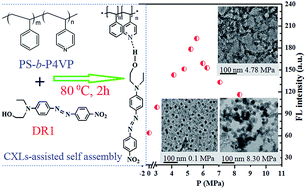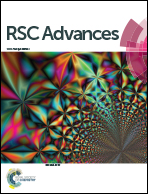CO2-expanded liquid assisted self-assembly between Disperse Red 1 and PS-b-P4VP
Abstract
This work shows that CO2-expanded liquids (CXLs) facilitate the modulation of morphology and photoluminescence (PL) performance of the self assembled fluorescent composite (SAFC), which was formed between Disperse Red 1 (DR1) and polystyrene-block-poly(4-vinylpyridine) (PS-b-P4VP) in CO2-expanded ethanol. We find that the anti-solvent effect of CXLs with increasing pressure could effectively regulate the amount and type of the hydrogen bonds with DR1 units as well as the confinement extent of DR1, along with the structure and fluorescence (FL) behavior of the SAFC. The morphology and emission behavior of the SAFC was strongly dependent on the CXL pressure and the molar ratio (R) of 4VP to DR1. The SAFC emission revealed a non-monotonic feature against CXL pressure, which increased with a pressure rise below the threshold pressure (PT) and then decreased at higher pressures above PT. The maximum FL of SAFC at 5.58 MPa and R = 2800 was enhanced by 3.4-fold compared with that of the pristine mixture. Confinement and hydrogen bonds are the two major factors responsible for the pressure dependence of the emission. Moreover, the hydrogen bonds formed between the DR1 and P4VP blocks are the principal contribution to SAFC emission than those between DR1 and ethanol.


 Please wait while we load your content...
Please wait while we load your content...